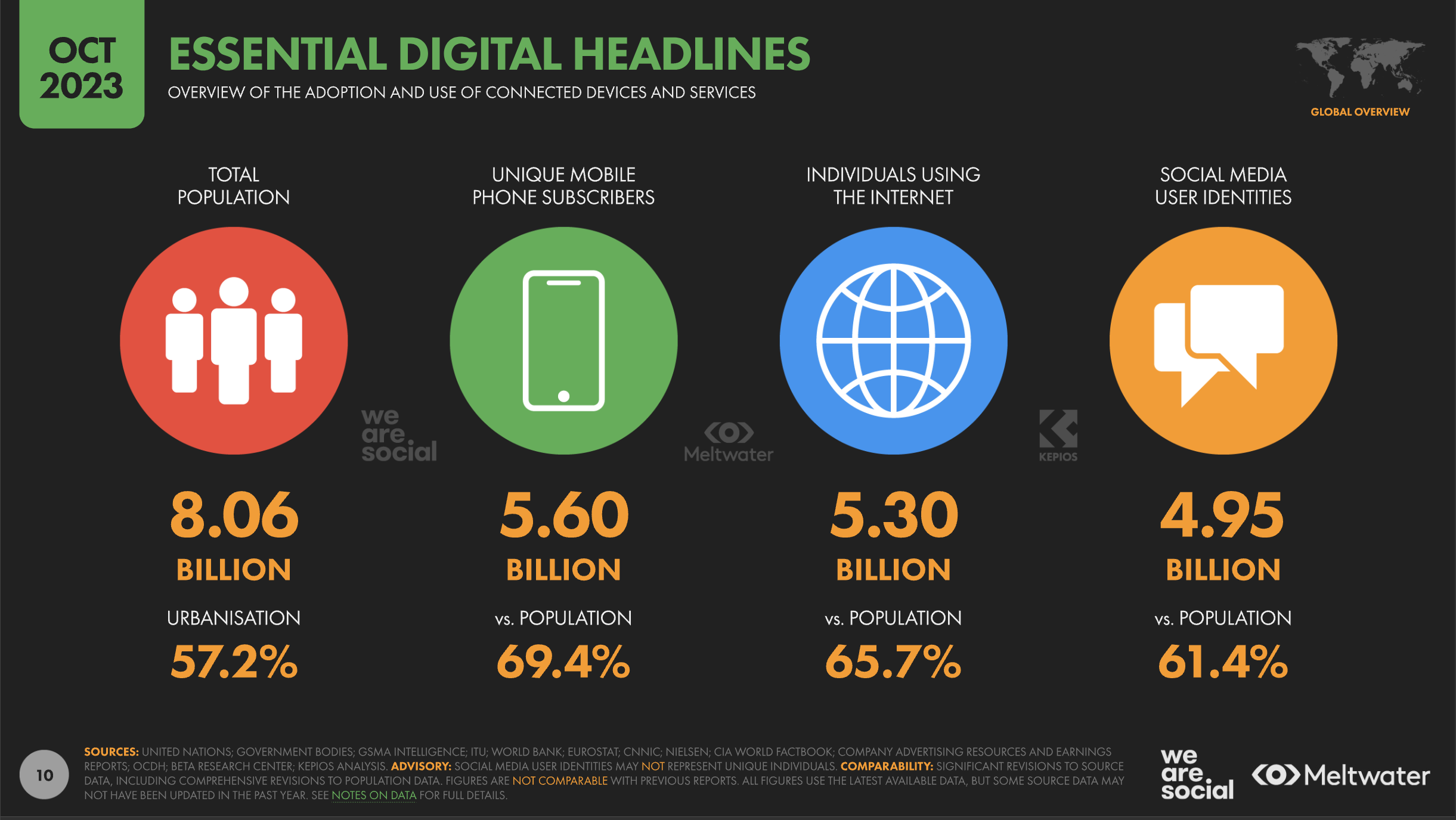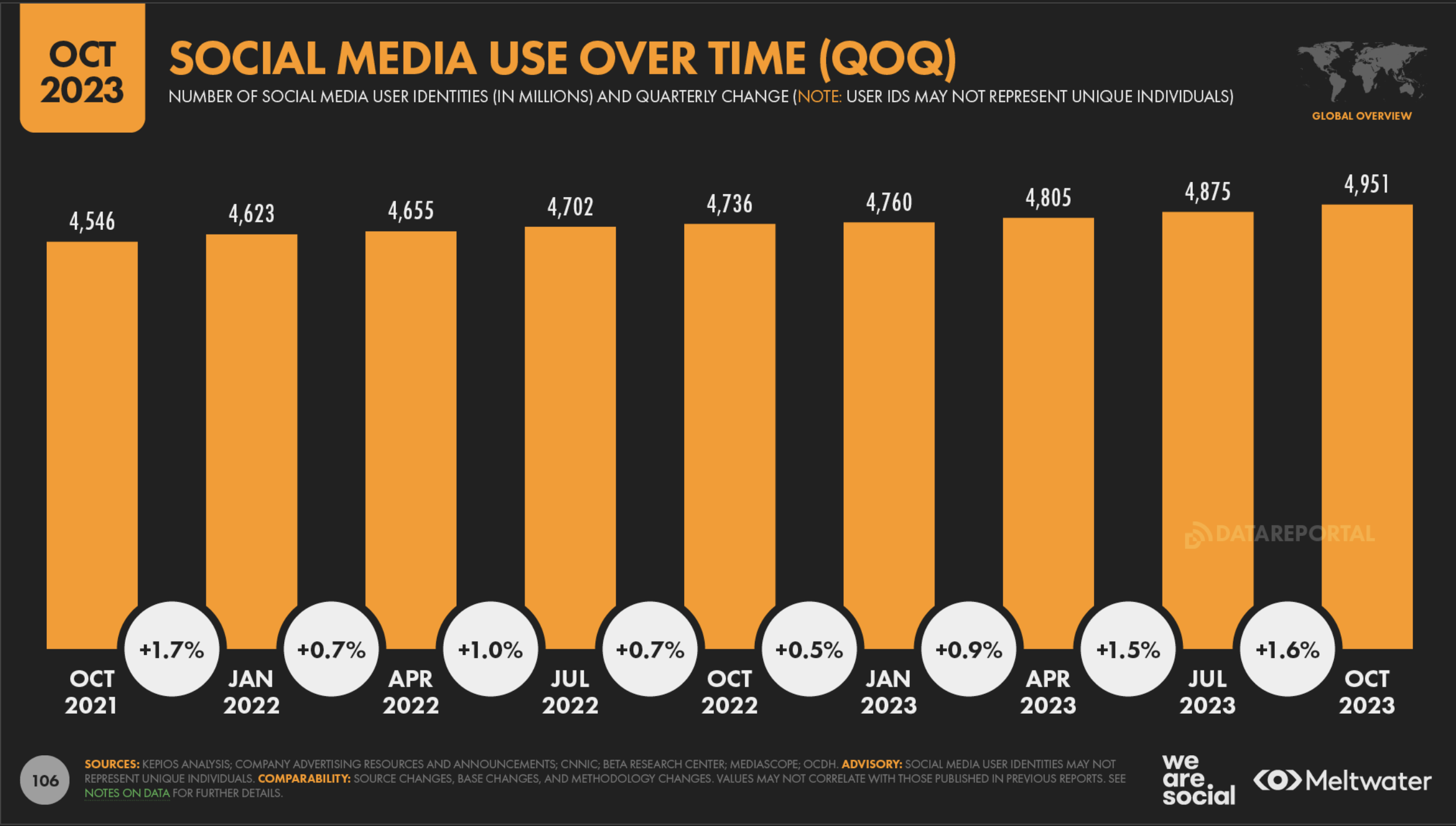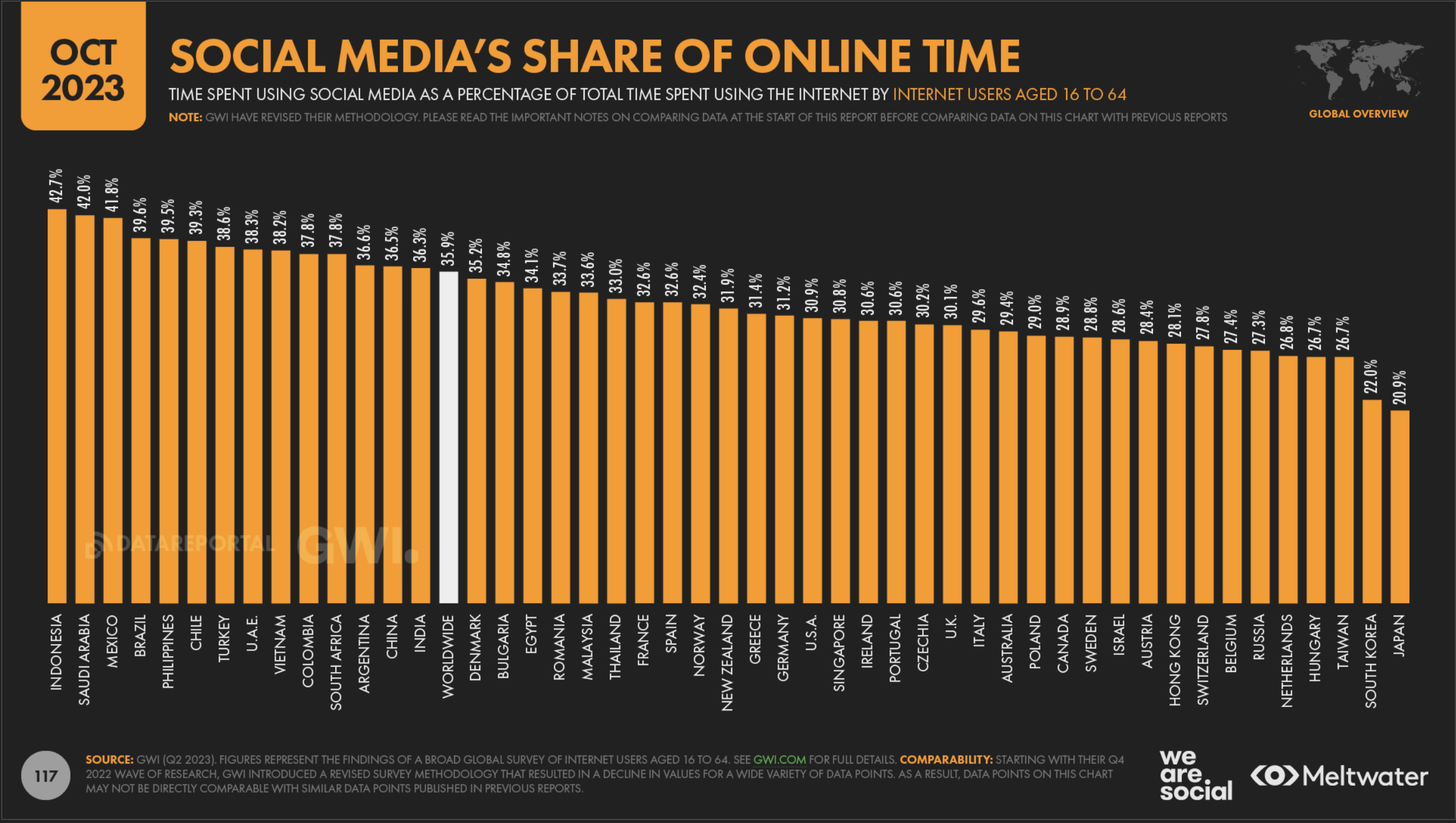Each quarter, Simon Kemp, his team and sponsors come up with the “state of the nation” when it comes to social media, the internet, mobile, etc.
The data is free, it is not gated and you can get access to it here.
And each quarter, I come up with my summary so you don't have to wade through the 300 slides.
Simon always writes a great narrative and so I have lifted this from his document and where I have done this, the text is in italics.
Let's get started.
The state of digital in October 2023
Kepios analysis shows that active social media user identities had grown to 4.95 billion by the start of October 2023, equating to 61.4 percent of the world’s total population. Active identities have increased by 4.5 percent since this time last year, thanks to the addition of 215 million new users.
The average person spends 2 hours 24 minutes, a day using social media.

Social adoption growing steadily
Social media users continue to grow at the faster pace we saw in our July 2023 data, and Kepios analysis reveals that user growth actually accelerated further during Q3.
Active user identities increased by 1.6 percent over the past three months, with an additional 76 million active users pushing the global total up to 4.95 billion by the start of October 2023.
For perspective, that means social media adoption has grown at an average rate of 9.6 users per second over the past 90 days.

Encouragingly, much of that growth has been fuelled by increased adoption across Africa, and the latest data reveal that social media adoption now exceeds 10 percent in every global region.
However, our latest numbers still point to low levels of active social media use across much of Sub Saharan Africa, with adoption only just above 10 percent in Middle and Eastern Africa.

A third of online time is spent on social
The mainstream media still seems to love churning out clickbait proclaiming that “social media is dead”, but if you’re starting to believe the headlines, we have news for you: it’s not.
(You have to remember that the mainstream media see social media as a competitor, which is why they keep trying to put it down. They want to go back to the days were there was no internet, we all read a newspaper and watched 4 channels on the TV. Think of it as asking one political party, thier opinion on another.)
As we’ve just seen, social media users continue to grow, and people are still spending roughly 2½ hours per day using social platforms.
Yes, average social media time has declined by a few minutes per day over the past year, but the typical working-age internet user still allocates more than one-third of their total online time (35.9 percent) to social media activities.

Organic social referrals have declined
So, based on the data in our study, we believe that organic social media referrals have indeed declined for consumer brands in most industries, and not just for large news brands.
But it’s important to note that there’s nothing in this data to tell us whether brands have simply reduced their organic social media activity over the past year.
And similarly, changing user behaviours may also have played a role in these trends.
For example, people have been spending an increasing share of their social media time using TikTok over recent months, and external links are a far less prominent feature of the TikTok environment compared with platforms like Facebook and X (Twitter).
(I still find it totally bizarre that brands / people still have the “post and hope” mentality, surely you want want to have everything backed with some sort of methodology, like for example the one we provide. That would give brands certainty and reduce the need for paid media.)
Is X dead?
The latest figures published in X advertising tools show a significant jump in reach over recent months
The platform formerly known as Twitter now reports that ads on its platform reach a total of more than 660 million users each month, with that figure up by a massive 18 percent over the past 90 days
These figures suggest that X’s ad reach has grown by more than 1 million accounts per day over the past three months, at an average rate of 13 additional accounts per second
Moreover, Semrush analysis suggests that twitter.com attracted more than 1.4 billion unique visitors in August 2023
Despite the “unique” terminology, there’s inevitably some duplication in that figure, and it’s probably more helpful to think of this number as “unique devices” rather than unique individuals
However, assuming that such duplication affects all sites to a similar degree, Semrush’s analysis puts X on a similar level to Wikipedia when it comes to global web traffic, which is testament to the enduring role that X plays in the world’s internet activities

Has Threads unravelled?
And it doesn’t look as though Threads will steal X’s lunch any time soon, either.
The latest insights from data.ai suggest that – despite enjoying the fastest app launch in history – the newest addition to Meta’s stable hasn’t maintained its promising initial momentum.
Indeed, data from a variety of sources suggests that active use of Threads has actually declined steadily since the week of its launch.
Having said that, Threads still attracted more than 100 million users in September 2023, so the app is far from a “failure”.
However, the outlook for Threads doesn’t look quite as rosy as it did back in July, and the app registered fewer than 20 million combined worldwide downloads across the Google Play and iOS app stores in September.
Stop expecting alchemy
Most of the marketers I speak with seem to be on a never-ending quest for a mystical “holy grail”.
No sooner have they added the latest shiny toy to their toolbox, they’re already asking, “what’s the next big thing?”
But new platforms and tools alone won’t make you a better marketer, just as collecting guitars won’t make you a better musician.
Rather than chasing shiny new toys, focus on how you can use what you’ve already got to create more value for your audiences, and deliver better outcomes for your brand.
Measure what matters
Goodhart’s law states that “when a measure becomes a target, it ceases to be a good measure”, and our industry provides ample evidence of this.
Marketers have become so obsessed with metrics like engagement, they’re even willing to spend money buying fake “engagement”.
This is the equivalent of offering a stranger $20 to tell you that you’re cool.
What’s the point? Ultimately, you’re only cheating yourself.
Yes, measuring tangible value contribution is difficult, and there’s no one-size-fits-all approach.
You need to put in hard work to get meaningful results.
But this is like getting fit: it’s really hard to get up off the couch, but the sooner you start, the sooner you’ll see results.
My advice is to start by asking yourself some simple questions:
- How do my team and I contribute to achieving those outcomes?
- How can we identify whether we’re actually delivering a meaningful contribution?
- What do we need to know to improve?
Focus on the answers to those questions, and you’re less likely to get distracted by meaningless tools and metrics.
Be remarkable
Differentiation is a core tenet of marketing: we need to give people clear and compelling reasons to choose our brand and its offerings over alternatives.
But most marketers seem to be preoccupied with copying other brands’ products and campaigns.
And the problem with this “me too” approach is that it’s unremarkable.
As one of my favourite adages states, “once you’ve seen the bandwagon, it’s already too late.”
Fundamentally, there are only two ways to differentiate: be better, or be different.
If you’re neither, your audience has no reason to notice you, which significantly reduces the chance of them choosing you.
Yes, being meaningfully better can be exceptionally difficult, especially in crowded markets.
And yes, being genuinely different requires great bravery, which is also exceptionally difficult when you must gain the approval of multiple stakeholders.
But therein lies a choice: you can either reconcile yourself to comfortable mediocrity – which is absolutely fine if that’s what you want – or you can commit wholeheartedly to the hard work required to achieve greatness.
The world of tech in 2024
But but but… what about the trends?
OK, if you absolutely insist on knowing which tech-related trends I’m watching most closely, here are my current top three:
Humanless transactions: I started exploring “marketing to the machines” back in 2016, but the concept has gained momentum with the rise of AI-powered assistants. This development poses existential challenges for marketing, not least because there’s a very real chance that people will “delegate” their decision making to algorithms – especially when it comes to low-involvement categories and repeat purchases. That future is likely still some way off, but in the short term, I expect to see a proliferation of content that has been produced almost entirely by algorithms, with the express purpose of influencing other algorithms.
Digital “geopardy”: as politicians the world over continue along a path of anti-diplomacy, I expect to see protectionism, antagonism, and conflict result in deteriorating digital experiences. Specifically, I think we’ll see more platforms being blocked, more feeds being co-opted for misinformation, and a further tendency towards content partisanship and extremism. Yes, that’s a pessimistic outlook, but you and I can still influence how this unfolds. Vote carefully. Stop using platforms that negatively affect your mental health and emotional wellbeing. Unfollow antagonists, and diminish their reach and influence by refusing to engage, no matter how “wrong” you think they might be. Above all, be intentional; the internet was never intended to be a “passive” medium, so don’t sit back and let the bots determine your destiny.
Intrinsic interfaces: innovations in areas such as gesture control will continue to change the way we interact with our devices. We’re still some way off from escaping screens completely, but motor movement sensors and ambient interfaces are increasingly finding their way into our everyday lives. Amongst other things, this shift away from screens will fundamentally change the dynamics of “content”, and require marketers to think beyond interruption as their primary means of introduction. As seems to be the case each year though, my advice here is simple: focus on how you’ll add value to your audience – not just on what the tech can do – and you’ll always be best placed for success.
That’s all for this year… I’ll be back with you in January to introduce our flagship Digital 2024 Global Overview Report, but until then, I hope you have a successful Q4, a relaxing break at the end of the year, and a great start to the year ahead.
I would like to thank
Simon is DataReportal’s chief analyst, and CEO of Kepios.
Click here to see all of Simon’s articles, read his bio, and connect with him on social media.
Want to know more about social selling, check out my new book
"social selling techniques to influence buyers and changemakers - 2nd edition".
In this brand new edition, I have updated all the text, I have also got 15 practitioners, so people who are doing this already to explain how they are get (practical) business benefit. From the CEO that has been running a digital business for over 18 months to sales leaders who use social selling every day.
Articles on how these business have and are implementing digital, from Mercer, Telstra Purple, Ring Central, Cyberhawk, Namos, Ericsson, DLA Ignite and more.
What does Mark Schaefer, Marketing guru think of the book "social selling - techniques to influence buyers and changemakers - 2nd edition"? watch the video here
It's available on Amazon worldwide. Link to Amazon.com here and Amazon.co.uk here.

 unknownx500
unknownx500











